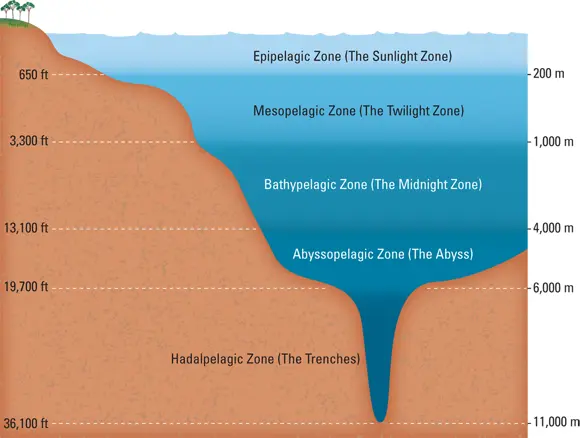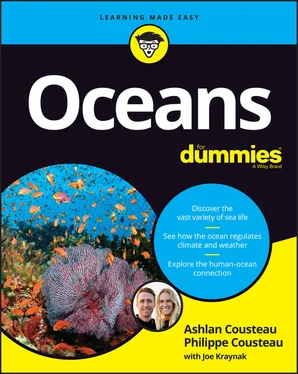Life in the low intertidal region is more aquatic; no surprise there, because everything’s submerged most of the day. Here, you find soft-bodied organisms, such as sea stars, sea slugs, sea urchins, and sponges, maybe even the occasional octopus (Philippe’s favorite sea creature), as well as turfing algae and seaweeds (marine plants that form mats).
 Algae is a staple of intertidal communities, forming the basis of most food webs.
Algae is a staple of intertidal communities, forming the basis of most food webs.
 COOL AND CREEPY
COOL AND CREEPY
You wouldn’t know it from looking at them, but sea stars are vicious predators — carnivores that can muscle open mussels and clams using their five mighty suction-cup-equipped arms. But that’s not even the coolest part. After gaining entrance, they literally spill their guts, ejecting their stomachs from inside their bodies, through their mouths to digest their prey. After dining, they suck their stomachs back in (not just in a vain attempt to look more fit). And they wonder why they can’t get anyone to come over for dinner.
Plants and animals living in the low intertidal region aren’t as well-adapted to hot spells and dry spells as organisms that live higher up in the intertidal zone. The good news is that they’re generally well-adapted to getting body slammed by waves that would otherwise push or pull them out to sea. If you’ve ever been rocked by a big wave, you know the feeling … well, actually you don’t really, because you’re a lot bigger than a tiny little crab. Inhabitants of the intertidal zone must feel like the world is crashing down on them every few seconds. But they’re tough, they’ve adapted, and now, for them, it’s just the way life is.
Wading through the neritic zone
When you start to need some sort of flotation device (or a boat) to keep your head above water, you’re in the neritic zone (also known as the sublittoral zone ). This area starts at the low tide mark and continues to the edge of the continental shelf in the ocean — about 200 meters (660 feet) deep. While that may sound really deep, it’s relatively shallow compared to how deep it gets out in the open ocean, which is much, much, much deeper.
Biodiversity is at its peak in the neritic zone, and no wonder — everyone wants to live here! Virtually every marine plant and thousands of coastal animal species (vertebrates and invertebrates) call this zone home. Consequently, the neritic zone is where 90 percent of all marine life resides. Diverse ecosystems flourish in and around coral reefs, seagrass beds, and kelp forests, all of which rely on sunlight-powered photosynthesis.
Why is it such a popular place? Well, conditions in the neritic zone are ideal for supporting diverse marine communities — the presence of sunlight throughout the zone; moderate, stable temperatures, pressures, and salinity; plenty of oxygen and carbon dioxide; and an abundance of nutrients that make their way from the land into the ocean (which under normal circumstances is good but can be bad when it’s too much).
In fact, the neritic zone is such a pleasant place, it’s also a popular hangout for sea creatures that move between deeper open ocean and shallow coastal waters, such as some sharks, turtles, and dolphins. And that’s not all — common visitors include those that feed in coastal waters but can also haul out onto land, such as some marine reptiles, pinnipeds (seals, sea lions, walruses), and penguins.
 Even though the neritic zone accounts for only about 10 percent of the ocean, it produces roughly 90 percent of all the fish and shellfish we harvest, making it very valuable for us humans too.
Even though the neritic zone accounts for only about 10 percent of the ocean, it produces roughly 90 percent of all the fish and shellfish we harvest, making it very valuable for us humans too.
Heading out to sea: The oceanic zone
The rest of the ocean that is neither intertidal nor neritic accounts for the oceanic zone. This vast, deep, inground pool comprises a huge chunk of Earth. It actually accounts for 95 percent of all the living space on the planet. Yet, it’s the part of the ocean (and part of the planet) we know the least about.
It starts from the edge of the continental shelf (the outer edge of the neritic zone) and extends all the way down to the seafloor 11,064 meters (36,300 feet) at its deepest point at the bottom of the Mariana (or Marians) Trench. In fact, it’s so deep, it had to be divided into zones, but let’s not get too deep into that here; depth is the topic of the next section.
While the diversity of species in the oceanic zone can’t hold a candle to the diversity in the neritic zone, the contrast in how life survives at the top and bottom of this zone can’t be beat. Near the surface, where sunlight penetrates, plants anchor the food webs and ecosystems. In contrast, on the seafloor, where it’s pitch black, ecosystems depend on either the remains of organisms that settle to the bottom or life that develops around hydrothermal vents and the bacteria that dine on the chemicals spewing from those vents.
So, what sort of life exists in the oceanic zone? Keep reading.
 HOW IS THE OCEAN LIKE A DESERT?
HOW IS THE OCEAN LIKE A DESERT?
Despite the oceanic zone’s enormity, it’s actually considered to be a marine desert because it’s so sparsely populated. When comparing the size of the oceanic zone to the number of species it contains, biodiversity here is relatively low.
Exploring the Five Vertical Zones of the Water Column
The ocean’s water column (a conceptual pillar of water measured from the ocean’s surface to the seafloor) is often divided into five zones — the epipelagic, mesopelagic, bathypelagic, abyssopelagic, and hadalpelagic zones (see Figure 4-2). The divisions generally correspond to differences in depth, amount of sunlight, temperature, pressure, nutrients, and organisms that live in those zones. In the following sections, we take a deep dive into each of the five vertical ocean zones.

©John Wiley & Sons, Inc.
FIGURE 4-2:The ocean’s vertical zones.
Skimming the surface: The epipelagic zone
The epipelagic zone (commonly referred to as the sunlight zone ) is the top 200 meters (about 650 feet) of the ocean, where enough sunlight is available for plant life to grow and support a large, diverse population of marine life. Because it forms the ocean’s surface, the epipelagic zone experiences greater variations (compared to the other vertical zones) in temperature and other conditions due to climate, local weather patterns, and proximity to large land masses.
Who lives here? Lots of plankton (tiny plants and animals that float, as shown in Figure 4-3); nekton (tiny plants and animals that swim); jellyfish; sea turtles (see Figure 4-4); a variety of fish including tuna (see Figure 4-5), marlin, salmon, and sharks; and cetaceans (dolphins and whales).

Courtesy of Christian Sardet/CNRS/Tara expeditions, from Plankton—Wonders of the Drifting World, Univ Chicago Press 2015. Licensed under CC BY-SA 4.0
Читать дальше

 Algae is a staple of intertidal communities, forming the basis of most food webs.
Algae is a staple of intertidal communities, forming the basis of most food webs. COOL AND CREEPY
COOL AND CREEPY Even though the neritic zone accounts for only about 10 percent of the ocean, it produces roughly 90 percent of all the fish and shellfish we harvest, making it very valuable for us humans too.
Even though the neritic zone accounts for only about 10 percent of the ocean, it produces roughly 90 percent of all the fish and shellfish we harvest, making it very valuable for us humans too.












